Creative Easter Crafts to Brighten Your Home
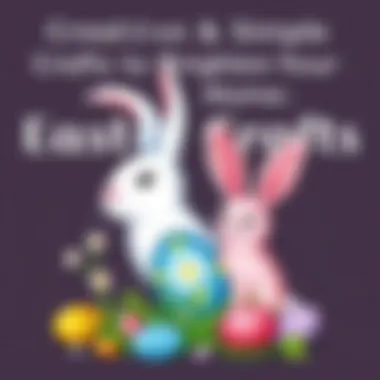
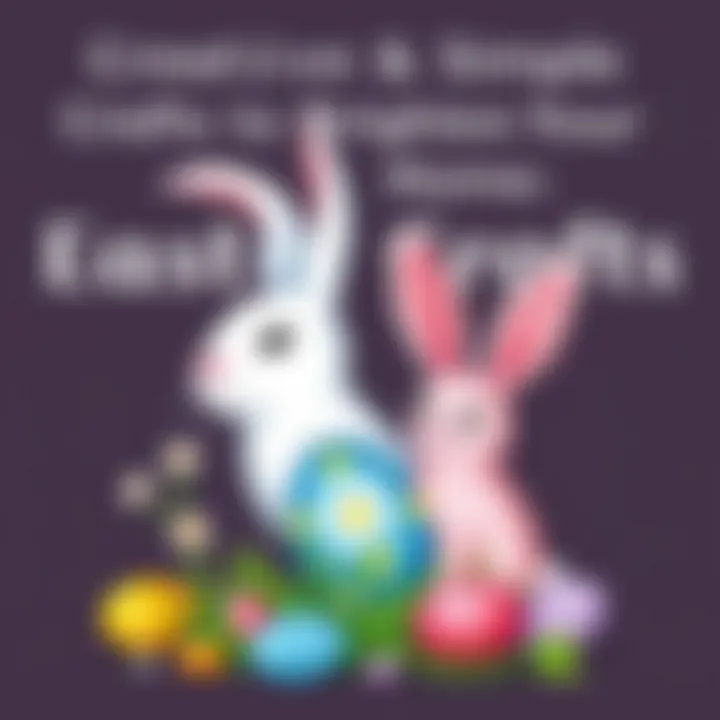
Intro
Easter, a season of renewal and creativity, is just around the corner. Families everywhere are on the lookout for meaningful ways to engage in the spirit of the holiday without breaking the bank. Crafting can transform this festivity into a colorful symphony of imagination and expression. Whether you are a parent itching to encourage creativity in your child or a caregiver seeking delightful activities, crafting is an excellent avenue to nurture that spirit.
This guide is a treasure trove of creative, simple Easter crafts, perfect for brightening your home and hearts. From painting eggs to creating delightful decorations, we delve into a variety of projects that beckon with minimal materials and maximum fun. Every craft explained here is more than just an activity; it’s an opportunity to bond, learn, and celebrate the essence of Easter in a hands-on way.
Let’s embark on this crafty adventure together!
Science Fun Facts
Easter isn't just about colorful eggs and bunnies; there’s some fascinating trivia that can make your crafting even more enjoyable. Did you know that the tradition of painting eggs dates back thousands of years? In many cultures, eggs symbolize rebirth and fertility.
"Eggs were seen as a symbol of new beginnings, and their colorful decoration showcased the joy of the season."
Here are some quirky facts to ponder as you dive into your Easter crafts:
- The word "Easter" is derived from the Old English word "Eostre," the name of a pagan goddess.
- The world record for the largest Easter egg hunt was set in 2017, with over 500,000 eggs hidden for eager participants.
- In some countries, eggs are not just painted but also intricately designed using a method called Pysanky, which involves wax-resist dyeing.
These insights not only enhance your knowledge but can also make great conversation starters during family crafting sessions!
Unique Craft Ideas
Below are a few unique Easter craft projects that are easy to follow and can spark creativity in children and adults alike:
- Eggshell Mosaic Art: Use real eggshells to create colorful mosaics. Just crush them and glue the pieces together in patterns on a sturdy cardboard base.
- Bunny Ears Headband: Craft an adorable bunny ears headband using construction paper. Get creative with colors, and add some cotton balls for a fluffy touch.
- DIY Easter Wreath: Use twigs, ribbon, and artificial flowers to make a beautiful wreath that can adorn your front door.
Each of these projects encourages creativity while strengthening family bonds. It’s learning and fun rolled into one festive package!
End
Celebrating Easter with crafts is an enriching experience that transcends age. These activities not only shower your home with festive cheer but also create lasting memories. So gather your materials, jump into these projects, and let your imagination run wild! Happy crafting!
Foreword to Easter Crafts
Easter is not just a time for egg hunts and family gatherings; it also serves as a canvas for creativity, connecting families through the joy of crafting. The importance of engaging in Easter crafts goes beyond mere decoration. These activities invite an opportunity for learning and bonding, fostering a sense of achievement and enhancing fine motor skills in children. Crafts can transform simple materials into vibrant masterpieces that bring life to our homes during this festive season.
Understanding the Importance of Crafts
Crafting during Easter has a timeless significance. It allows families to explore their artistic side while teaching children about patience and persistence. Each craft project is a small journey - whether it’s creating a homemade wreath or dyeing eggs using natural ingredients. These activities illuminate the essence of the holiday, promoting values such as creativity and resourcefulness. Moreover, incorporating traditional motifs, such as bunnies and eggs, can deepen the understanding of Easter and its cultural aspects.
Additionally, crafts can act as a medium for communication within families. Working together on projects encourages dialogue and creativity exchange, allowing ideas to circulate freely. The atmosphere becomes charged with excitement, especially when kids can contribute their unique perspectives. Every creation, cast in the glow of family involvement, becomes a cherished memory.
The Joy of Crafting Together
Crafting isn’t just about the end result; it’s about the process and enjoyment derived from working as a team. Children often thrive on imitation and shared experiences, making joint activities enriching. When parents or caregivers join forces with children for crafting, it transforms the simple act into a joyous occasion.
Families can share laughter and stories as they glue, paint, and create side by side. For example, painting eggs can turn into conversations about favorite colors or funny childhood memories. This simple act fosters connections that last beyond the crafting table.
Moreover, crafting together instills a sense of belonging. Children feel valued when their parents partake in their creative efforts, boosting their self-esteem. They take pride in the crafts they make, knowing that these creations arise from shared experiences. Nature also flourishes during these moments, as kids explore colors, textures, and the beauty of working with their hands.
By engaging in Easter crafts collectively, families create not just decorations for their homes, but treasured memories that can be revisited and celebrated for years to come. It’s a heartwarming reminder that the true spirit of Easter is not merely about the crafts but rather the connections created while making them.
Materials Needed for Crafting
Crafting for Easter is not just about creating beautiful decorations; it’s about bringing families together and igniting creativity. The materials you choose play a pivotal role in shaping these artistic experiences. Using the right materials can simplify projects and make them more enjoyable for everyone involved. When choosing materials, one must consider accessibility, safety, and environmental impact, especially since the target audience includes young children and their families.
Common Household Items
Not every crafting project needs a run to the store. In fact, many projects can be born out of items we already have lying around the house.
- Toilet Paper Rolls: Think beyond the bathroom. These can become bunnies or colorful decorations with just a splash of paint or some crafty embellishments.
- Old Magazines and Newspapers: Perfect for decoupage projects. Cutting up images can also lead children into discussions about recycling, helping them understand why these materials can visually enhance their crafts.
- Cardboard Boxes: Instead of trashing that shoe box, turn it into a decorative basket or part of a whimsical diorama.
People often overlook materials, but these everyday items can inspire creativity and resourcefulness.
Eco-Friendly Options
In today’s climate, the art of crafting can align beautifully with our responsibility to the planet. Eco-friendly crafting not only nurtures creativity but also offers a teaching moment about sustainability. Individuals concerned about waste benefit immensely from these choices.
- Recycled Paper: Look for old wrapping paper or leftover art projects. It’s a great way to avoid additional waste and can become part of unique new creations.
- Natural Dyes: Instead of chemical-laden dyes, explore techniques using items like beet juice or turmeric to color eggs or paper. It’s much safer for children and results in naturally beautiful hues.
- Biodegradable Glitter: Crafting can get sparkly without harming the environment. This glitter shimmers just like traditional options but won’t contribute to plastic pollution.
“Crafting is an opportunity to teach little ones about the importance of creativity and caring for our planet at the same time.”
Choosing eco-friendly options during crafting isn't just a trend; it’s building a way of thinking that inspires children to consider their choices long after the Easter season.
By focusing on common household items and eco-friendly options, crafting becomes a blend of imagination, education, and responsibility. Families can enjoy quality time together, creating Easter crafts that are not just visually appealing but also have a meaningful impact on their lives and the environment.
Creating Easter Eggs
Easter eggs hold a special place in the hearts of many during the spring season, marking a blend of tradition, creativity, and family bonding. Crafting Easter eggs can elevate the festive spirit in any household. They're not just colorful decorations; these eggs are a canvas for expression and imagination. Families can come together, experimenting with various designs and techniques that help to instill appreciation for this holiday's cultural significance. Engaging in such activities reinforces patience and attention to detail, qualities often sidelined in a fast-paced world.
Through the act of crafting Easter eggs, connections are made, stories are shared, and memories are created—all essential elements in building a nurturing home environment.
Natural Dye Techniques
One of the most rewarding aspects of creating Easter eggs is the use of natural dyes. Natural dyes not only provide vibrant colors but also align with eco-friendly practices that families may wish to embrace. Items from your kitchen can serve as excellent sources: beets yield a rich pink, while turmeric gives eggs a sunny yellow hue. Collecting these ingredients can itself be a fun family outing, perhaps a trip to the farmer's market or a backyard foraging adventure.
To dye eggs using natural methods, follow these steps:
- Choose Your Base: Start with hard-boiled eggs. Allow them to cool completely.
- Prepare Your Dye: Chop veggies or fruits to create dyes, boil them in water with some vinegar. Strain the liquid to remove solids.
- Dye the Eggs: Submerge eggs in the dye and let them sit. For deeper colors, leave them overnight in the fridge.
- Rinse and Dry: Once finished, gently rinse your eggs and let them dry.
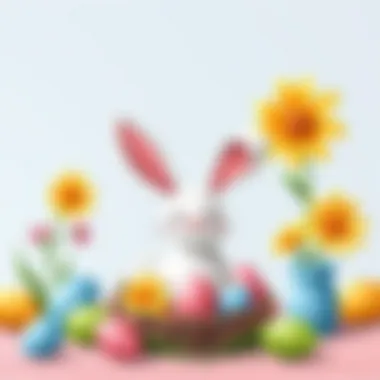
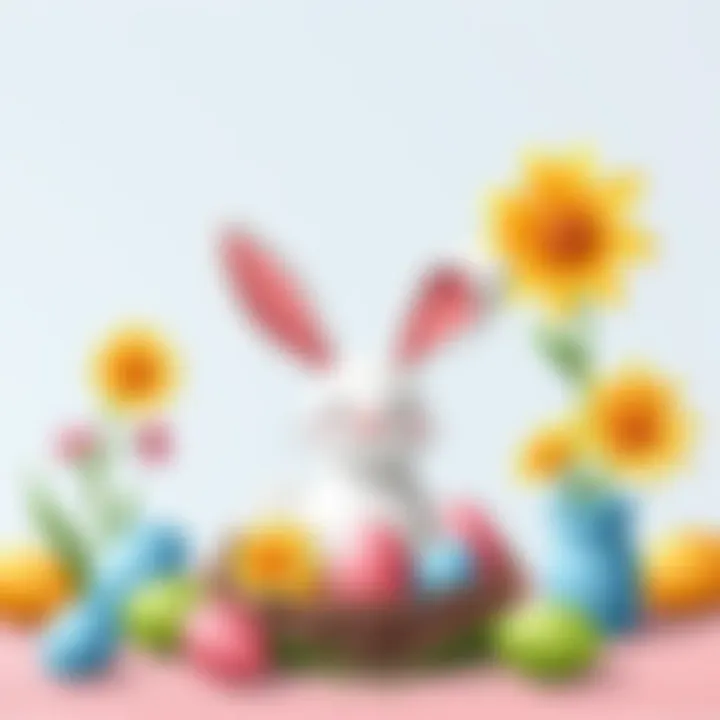
This technique not only brightens your eggs but also introduces children to shades you can get right from nature.
Decoupage Techniques
Decoupage might sound fancy, but it’s as straightforward as pie and offers a unique twist on decorating eggs. This technique involves gluing materials onto your eggshell to create beautiful designs. Think of bits of colored paper, fabric, or even magazine clippings that resonate with the Easter theme.
To get started, gather these materials:
- Hard-boiled eggs
- Decoupage glue or diluted white glue
- Small paintbrush
- Scissors
Here’s how to do it:
- Cut Your Designs: Snip your chosen paper or fabric into small pieces.
- Apply Glue: Use the paintbrush to apply a thin layer of glue to a small section of the egg.
- Stick Your Pieces: Lay a piece of your design over the glued area, smoothing out wrinkles as you go.
- Finish: Once complete, apply a top coat of glue to seal everything. Let dry completely.
The result? Customized eggs that showcase individuality and flair. Plus, it’s a perfect opportunity to discuss art techniques—talk about layering and composition!
Psychedelic Egg Patterns
If you and your family are looking for something a bit more adventurous, consider crafting a psychedelic egg! Using a simple method of marbling, you can create vibrant, swirling patterns that burst with energy. This technique is engaging and provides room for unexpected results, sure to impress young and old alike!
Here’s how to make those wild designs:
- Gather Supplies: You'll need hard-boiled eggs, shaving cream, food coloring, and a toothpick or skewer.
- Prepare the Base: Spread a layer of shaving cream on a tray and drip different colors of food coloring onto it.
- Marble It Up: Use the toothpick to swirl the colors together.
- Roll the Eggs: Roll your eggs in the cream, covering them entirely.
- Set and Clean: Let them sit for about 10 minutes and then rinse off the shaving cream to reveal the pattern.
Psychedelic eggs are not just a feast for the eyes, they allow kids to embrace their creativity. Allows for a colorful spin on traditional Easter sentiments, showcasing the beauty found in chaos.
Creating Easter eggs involves fun techniques that bring families closer together, bridging the gap between art and tradition. Each method empowers every member of the family to express themselves, ensuring that this Easter will be unforgettable.
Easter-Themed Decor Ideas
Easter is more than just a holiday; it’s an opportunity to breathe life, color, and creativity into your home. When it comes to decorating, the goal isn’t just to spruce things up but to create an atmosphere that embodies the joyous spirit of the season. This section encapsulates the essence of Easter-themed decor ideas, ranging from festive wreaths to vibrant flower arrangements. Amidst chocolate bunnies and egg hunts, the magic of decor lies in its ability to transform mundane spaces into a warm and welcoming haven, making it essential for families to partake in these craft projects together.
Creating Festive Wreaths
Crafting Easter wreaths can become a cherished family tradition. Using simple materials like colorful paper, twigs, and even plastic eggs, you can create a centerpiece that welcomes guests and sets the tone for festivities. What’s essential is to get creative. A wreath doesn’t have to be a circle made of flowers; think outside the frame! For instance, by using natural vines, you can intertwine pastel-hued ribbon and crafted flowers to create a delightful centerpiece.
Steps to Create a Festive Wreath:
- Gather Your Materials: Gather up twigs, ribbon, faux flowers, and plastic eggs.
- Make a Base: Start by forming your base with twigs, twisting them into a circular shape.
- Add Decorations: Attach flowers and eggs to the base. Secure them with glue or tie them with ribbon for a personal touch.
- Hang with Flair: Finally, use a bold ribbon to hang your wreath on your front door.
The act of creating wreaths as a family can spark conversations and creativity. Besides, it’s not just about the end product, but the laughter shared around the crafting table that makes memories last.
Decorative Egg Baskets
Another delightful craft are decorative egg baskets. This project enhances an already festive scene while also offering a functional element for all those Easter eggs you might gather. Whether you opt for traditional woven baskets or decide to craft paper mâché versions, the key is to infuse them with colors that pop! Consider using vibrant paints or eco-friendly materials to paint your masterpieces.
How to Craft Decorative Egg Baskets:
- Choose Your Basket Form: If you’re feeling adventurous, create a basket out of paper mâché for a unique experience.
- Paint and Decorate: Use bright, cheerful colors. Stickers or embellishments can add an extra flair!
- Fill with Treats: Once your baskets are complete, fill them with painted eggs, grass, or even Easter treats.
Just envision the joy on children’s faces when they see these beautifully crafted baskets ready for the egg hunt. They not only look stunning but also serve as keepsakes to remember the crafty day.
Paper Flower Arrangements
Lastly, let’s discuss paper flower arrangements. These blossoms can brighten any corner of your home without wilting. With simple origami techniques, families can create colorful bouquets that represent the vibrancy of spring. The beauty of paper flowers is that they require minimal supplies and can be personalized in countless ways.
Steps for Paper Flower Arrangements:
- Gather Supplies: You’ll need colored papers, scissors, and a glue stick.
- Create Flower Petals: Cut your paper into petal shapes. The more varied the shapes, the more unique your flowers.
- Assemble: Glue petals together to create blossoms and consider adding paper leaves for detail.
- Display: Place your paper flowers in a vase or even attach them to branches for a creative centerpiece.
Creating these arrangements can teach kids about shapes and colors while also nurturing their artistic skills. As you display your paper blooms, you invite spring into your home, celebrating the season’s beauty in full bloom.
Crafting Easter decor is more than mere decoration; it’s about creating lasting memories and instilling a sense of togetherness.
In essence, the incorporation of these Easter-themed decor ideas not only beautifies your space but also strengthens family bonds through shared creative processes. Each wreath, basket, or flower made together is not just a craft; it’s a story you carry forward into the future.
Fun and Interactive Easter Games
Engaging in fun and interactive games during Easter plays a crucial role in enhancing the festive spirit. These games not only serve as entertainment but also promote family bonding, cooperation, and a sense of accomplishment. When families come together to partake in these joyful activities, it transforms ordinary moments into cherished memories.
Moreover, Easter games can be educational, subtly incorporating learning elements that help children develop skills while having a blast. They can improve social skills, such as communication and teamwork, which are essential as kids grow up. Balancing fun with learning is the secret sauce that makes these games a hit among various age groups.
Egg Hunt Preparation
Preparing for an egg hunt can feel like orchestrating a mini-festival right in your backyard or living room. First, you need to gather your materials. Invest in colorful plastic eggs that can be filled with small treats or surprises. You can use chocolates, stickers, or even tiny toys. Don't forget to have a basket or bag ready for each child to collect their treasures!
When setting up the hunt, think creatively about hiding spots. Here are a few ideas to get your imagination ticking:
- Behind trees: If you’re outdoors, hide eggs at different heights and depths behind bushes or behind larger trees.
- Under cushions: Indoors, placing eggs beneath couch cushions adds an element of surprise.
- In shoes: Placing eggs in children's shoes creates a fun discovery moment as they check for their favorite footwear.
- On windowsills: This can also work for both indoor and outdoor hunts; just be aware of the height, especially if the kids are younger.
Encourage teamwork by letting older siblings help younger ones—it's a wonderful opportunity to build their relationship. You can also create a map for children to make it feel like an adventure.
Crafting Game Cards
Crafting game cards can take your Easter festivities to the next level. These personalized cards can be used for various games, like bingo or matching games with Easter-themed images. Creating these cards can become a fun craft project itself!
To start, gather materials like colorful cardstock, markers, and decorative items like stickers or glitter. Here’s a simple step-by-step guide:
- Design the Cards: Start by cutting cardstock into your desired size for each card. Consider Easter themes like bunnies, eggs, or flowers.
- Add Images: Draw or print pictures related to Easter. Kids can draw their own designs as well, letting their creativity shine.
- Make It Interactive: You could convert them into a bingo game where kids can mark off images as they find them during the egg hunt.
- Decorate: Use stickers or colorful markers to make each card unique and special. This allows kids to express their own personalities through their cards.
- Playtime: Once your cards are done, introduce a gaming session where the whole family can engage in playful competition or collaboration.

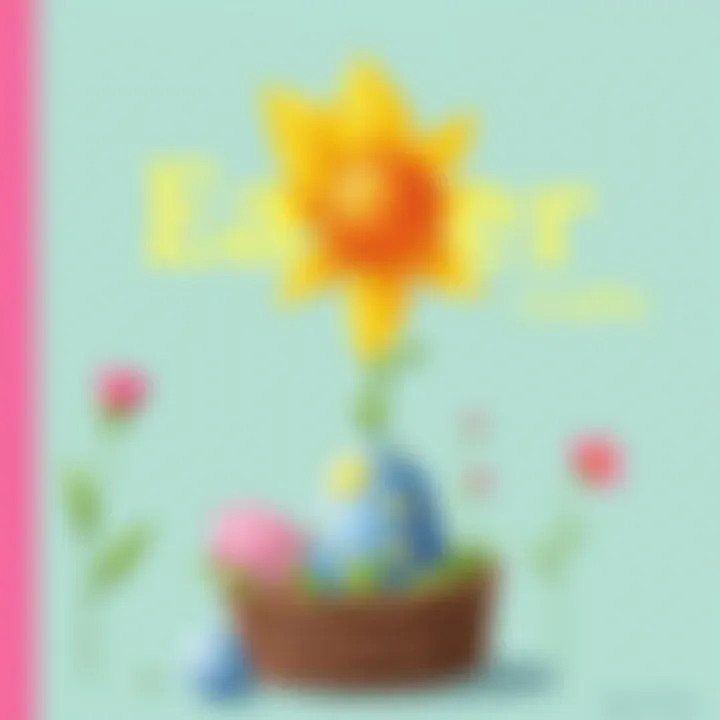
By infusing these elements into your Easter celebrations, you create a dynamic atmosphere that emphasizes togetherness and learning. Looking beyond the usual, these games cultivate lasting memories and spark joy in the simplest of ways.
Educational Aspects of Crafting
Crafting is more than just a fun pastime—it's a valuable educational experience for both children and adults. In the context of Easter crafts, the season provides an excellent opportunity to dive into activities that are not only enjoyable but also educational. This section discusses the significant benefits of crafting during this festive time, focusing on enhancing motor skills and fostering creativity.
Enhancing Motor Skills
Creating Easter-themed crafts, such as decorated eggs or bunny sculptures, requires specific hand movements that can boost fine motor skills in young children. These skills are crucial for various everyday tasks, like writing or using utensils.
- Fine Motor Development: When children engage in activities such as painting, cutting, and gluing, they practice precision and control with their hands. This is particularly vital for preschoolers as their hand-eye coordination is still developing. Each tiny action contributes to their overall dexterity.
- Problem Solving: Many crafting projects involve following patterns or instructions that need careful handling of tools. For instance, if a child tries to cut out intricate shapes from colored paper, they enhance their ability to focus and solve problems.
- Concentration and Patience: Crafting requires kids to stay focused on a task for a period. Completing a project, from drawing the outline to the final embellishments, teaches children the importance of patience and persistence.
"Crafting isn’t just about making things; it’s about learning through doing. Every snip of the scissors is a step towards mastering fine motor skills."
Fostering Creativity and Imagination
Crafting brings out the artist in everyone, particularly during Easter, when vibrant colors and fun shapes abound. It serves as a canvas for imagination. Here’s how it encourages creativity:
- Expressing Ideas: Children have the chance to express themselves in ways words cannot. An awkwardly shaped Easter egg may spark laughter and joy, leading to dynamic discussions about what art represents.
- Innovative Thinking: Having the freedom to choose colors and design elements fosters innovative thoughts. Maybe they want a polka-dotted bunny—who's to stop them? Such choices motivate imaginative processes and risk-taking in art.
- Cross-Disciplinary Learning: Crafting can also interweave with science, math, and literature. For example, discussing the geometry of cutting paper into shapes or sharing stories of the Easter Bunny enhances their learning experience beyond the craft itself.
Ultimately, the educational aspects of crafting extend far beyond the immediate activity. They provide a framework for growing crucial life skills in children while also allowing families to come together and create lasting memories.
Sustainability in Easter Crafts
Sustainability in Easter crafts is not just a trend; it’s becoming an essential aspect of creating a mindful celebration. Integrating eco-friendly practices into your crafting not only helps the environment but enhances the meaning of the holiday. By using sustainable materials, families can instill values of resourcefulness and care for our planet in children from a young age.
When we think about Easter, images of vibrant decorations and festive activities come to mind. However, the impact on the environment can often be overlooked. Traditional crafting materials may include elements that do not biodegrade well, contributing to waste that lasts far beyond the Easter season. Therefore, one must consider alternatives that require fewer resources and are kinder to our earth.
Moreover, sustainability encourages creativity. When families are prompted to look around their homes for items that can be repurposed, it sparks imagination. This process not only fosters a connection to the environment but also engages children in problem-solving exercises as they transform what might be considered "trash" into treasures.
Incorporating sustainable practices during Easter can also make traditions more meaningful. Using materials from nature, such as bamboo or recycled paper, helps create a seasonal atmosphere that aligns with the essence of renewal and growth that Easter signifies.
"Crafting with consideration is cultivating a garden of creativity while respecting our shared home."
Recycling Materials for Easter Projects
Recycling materials for Easter crafts is a brilliant way to keep the festivities lively without cluttering landfills. You could dive into that old stack of newspapers, cardboard boxes, or even glass jars, which can be easily put to good use. Not only can these items be transformed into charming decorations, but they also come with the bonus of teaching children about recycling practices.
Here are some ideas on how to recycle materials:
- Newspaper Eggs: Using delicate layers of old newspapers, you can create unique paper mâché eggs. Simply mix water and flour to create a paste, dip strips of paper, and lay them over a balloon. Once dried, pop the balloon and paint the egg!
- Cardboard Cutouts: Transform cardboard from old packages into delightful Easter shapes — think bunnies, chicks, and eggs. Kids can paint or decorate these cutouts for a personalized touch.
- Glass Jar Lanterns: Clean out those old food jars and turn them into lanterns. Paint them with vibrant colors or wrap them in twine for a rustic look, and place them around your home for a festive glow.
Fostering a recycling habit in your family during Easter not only adds a unique flair to your home décor but also emphasizes the importance of reducing waste.
Using Organic Dyes
Adding vibrant colors to your Easter crafts can be done in a safe and eco-friendly manner through the use of organic dyes. Instead of opting for chemical-laden dyes, why not experiment with colors derived from natural sources? This approach sends a powerful message about being conscious of what we allow into our lives.
There are lots of options available right in your kitchen!
- Beet Juice: Create stunning shades of pink or red by boiling beets in water. The longer you boil, the more intense the color.
- Turmeric: For a sunny yellow, mix turmeric powder with water. Just a small amount can produce striking hues.
- Spinach or Kale: If green is your color of choice, boiling spinach or kale leaves will give you a lovely green dye.
Using these organic dyes not only enhances your crafting experience, but it also provides an opportunity to discuss the benefits of natural products with your children. This becomes an engaging way of teaching them about the earth’s resources, as well as promoting a healthier lifestyle.
Personalizing Your Easter Crafts
Personalizing your Easter crafts adds a special touch that can truly elevate your festive spirit. It's about more than just creating beautiful items; it’s about infusing each creation with personal meaning and memories. Customizing your crafts makes them shine with personality, encouraging family members to express their individuality. This is particularly beneficial when working with kids, as they get to leave their unique mark on the projects.
Family Handprints
Handprints can tell a story in a way that few other crafts can. They are a literal representation of each family member during a special moment together, a keepsake that captures the essence of your family at a specific time. Each handprint is unique; no two are ever alike, making it an ideal choice for personalization.
To start, gather some basic materials: non-toxic acrylic paint, a canvas or sturdy cardstock, and some paintbrushes.
- Select Your Colors: Choose an array of colors that resonate with spring and Easter—the pastels often evoke a warm feeling of renewal and celebration.
- Preparation: Lay down newspapers or an old tablecloth to keep your workspace clean.
- Inking the Hands: Apply paint to each family member's hands, ensuring even coverage. Bring them together, and gently press down onto the canvas. Each print will overlap and come together, forming a unique piece of art.
- Add Details: Once the paint dries, consider adding names or dates next to each handprint. You could also add embellishments like flowers or bunnies around the edges to make it festive.
Handprint crafts hold the power to bridge generations; in years to come, family members can look back and reminisce about the time spent creating together.
"Crafting is a tapestry of memories, woven with the threads of creativity and love."
Customized Egg Designs
Egg decorating is a tradition that lies at the heart of Easter celebrations. However, when it comes to customizing egg designs, the sky is the limit. This craft can be approached in myriad ways, allowing families to cultivate creativity with each stroke of color.
Start with some hard-boiled eggs or plastic eggs, depending on your preference for sustainability and durability. Gather supplies such as permanent markers, stickers, or paints.
- Choose a Theme: Decide on a theme before diving in. Whether it is nature, favorite animals, or simple geometric patterns, it gives a creative direction.
- Sketch It Out: If you have a specific design in mind, lightly sketch it on the egg with a pencil. Kids, depending on their ages, can either go wild with colors or follow a set pattern.
- Coloring: Use permanent markers for intricate designs or paints for a more colorful approach. Don’t hesitate to mix different mediums, combining paints with stickers to create a unique look.
- Seal the Deal: After allowing the designs to dry, consider applying a clear sealant spray to protect the artwork.
Customized egg designs not only celebrate Easter but also serve as storytelling pieces. Each egg can represent something special—perhaps a loved one’s favorite color or an inside joke among family members.
By taking the time to personalize these crafts, you build precious memories while introducing children to the joys of self-expression and creativity.
Incorporating Science into Crafts
Integrating science into Easter crafts not only makes the creative process engaging but also educational. This fusion helps children understand real-world concepts through hands-on activities. Crafting doesn’t have to be solely about aesthetics; it can serve as a gateway to explore fundamental scientific principles, setting the stage for a richer learning experience. By using everyday materials, families can delve into various scientific inquiries that arise during crafting.
When children mix paints or create dough, they are practicing color theory and chemistry. These interactions enhance their problem-solving skills and critical thinking. Additionally, discussing the processes involved in these crafts can foster curiosity about how the world works, making it an enjoyable, multi-dimensional experience.
Understanding Color Mixing
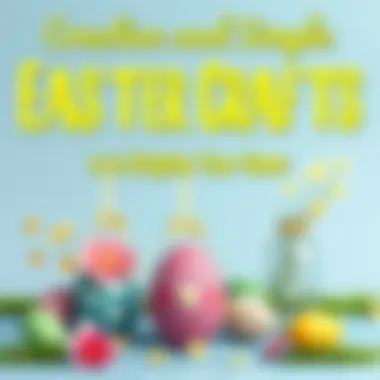
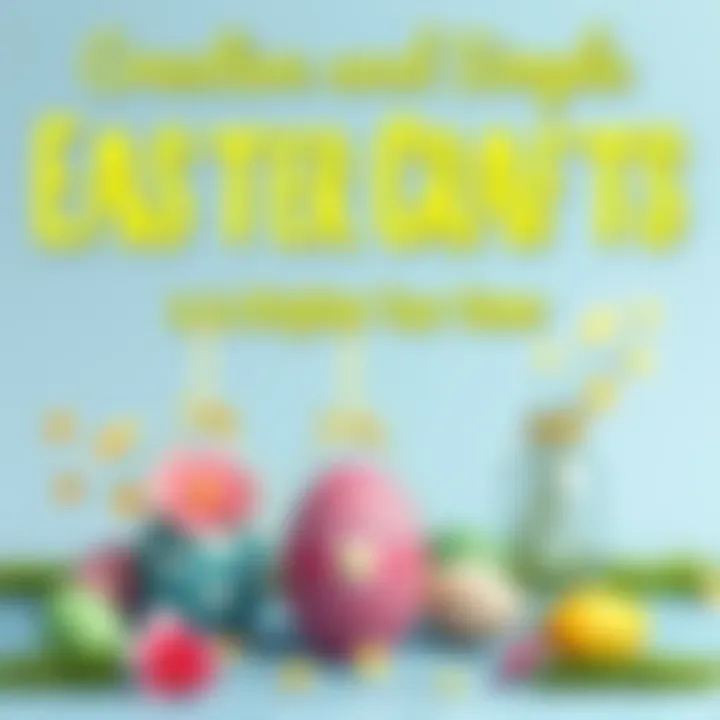
Color mixing is an intriguing aspect of crafting that captivates both children and adults alike. By deeming primary colors—red, blue, and yellow—kids not only mix these hues to create new colors but also gain insight into the basics of color vision and perception. This hands-on activity is often seen when painting eggs or creating vibrant decorations.
To experiment with color mixing:
- Provide primary-colored paints and a palette.
- Encourage children to blend different combinations and observe the hues produced.
- Ask questions like, "What happens when you mix blue and yellow?" or "Can you create a shade that resembles the grass outside?"
This experiential learning allows kids to visualize relationships between colors and keeps their creativity blooming.
"Color mixing isn't just an art; it's a lesson in observation and experimentation."
Graphing and Measurement Activities
In the course of Easter crafting, there are ample opportunities to incorporate graphing and measurement activities. When measuring supplies or tracking items for decor, children practice math skills in a fun environment. This hands-on approach demystifies numbers and engages children’s natural inclination toward exploration.
Here’s how to create an engaging graphing activity:
- Egg Decorating: Have kids decorate a certain number of eggs and categorize them by color or design (polka dots, stripes, solid colors).
- Graphing: Use graph paper to create a visual representation of the results.
- Discussion: Talk about which color or pattern was the most popular, and why the children think that is. This encourages them to analyze data and draw conclusions while having fun.
- Each color or design gets its own column.
These math-infused crafts will not only yield vibrant decorations but also instill a sense of achievement and understanding in young minds. Crafting, intertwined with scientific principles, opens doors to both creativity and analytical thinking.
By enhancing these crafting experiences, families can foster an environment where learning is both enjoyable and impactful.
Safety Tips for Crafting with Kids
When diving into the joyous world of Easter crafting with kids, ensuring safety is paramount. Crafting can be a delightful and enriching experience, promoting creativity and motor skills. However, it simultaneously presents potential hazards. Recognizing these risks is crucial for a smooth and enjoyable crafting session that instills confidence and curiosity in young crafters.
Understanding the safety aspects allows both parents and children to immerse themselves in activities without holding back. Here are a couple of essential points that highlight the significance of prioritizing safety during these crafting moments:
- Building Trust: When children feel secure and supervised, they're much more inclined to explore their creativity. It's essential that they understand the importance of safety measures from the get-go.
- Promoting Responsibility: Teaching kids about safe practices helps them become more cautious and responsible individuals, both in crafting and in other life situations.
"Safety first! That’s the motto in both crafting and life."
Choosing Age-Appropriate Materials
Selecting the right materials is arguably one of the most crucial steps in ensuring that crafting is both enjoyable and safe for young hands. Here are several considerations for choosing age-appropriate crafting supplies:
- Non-Toxic Options: Always opt for non-toxic paints, glues, and other materials. Children tend to explore everything with their mouths, so it’s wise to ensure that what they use is safe even if accidentally ingested.
- Size Matters: Avoid small items like beads or buttons for younger children, as these can pose choking hazards. Instead, larger items or soft materials should be on the menu to keep little fingers safe.
- Clean Up Easily: Materials that are easy to clean up can be beneficial, especially when working with younger children who may be less careful with their supplies. Consider washable markers or easy-to-clean paint.
Supervision and Tools
No matter how age-appropriate the materials, supervision remains critical during any crafting session involving children. This ensures safety while enabling guided exploration. Here are some ways to effectively supervise your young crafters:
- Active Engagement: Stay involved in the crafting process. By participating in the session, you not only monitor for safety but also encourage creativity and collaboration in crafting.
- Designated Craft Zone: Establish a specific area for crafting, ideally a space that can be easily cleaned or one that’s already a bit messy. This keeps the chaos contained and helps focus the children’s attention.
- Suitable Tools: Ensure you provide appropriate tools such as child-safe scissors rather than standard ones. Adult supervision can also guide their usage to prevent accidents.
- Demonstrate Proper Use: Before letting children handle tools, demonstrate their safe use. They will be more attentive if they see you handling tools correctly first.
By implementing these safety tips, families can create not just crafts but cherished memories during the Easter season and beyond.
Documenting Your Crafting Journey
Crafting is not just about creating a finished product; it’s about the experiences and memories built along the way. Documenting your crafting journey plays an integral role within that experience. It allows families to look back on the time spent together, reflecting on both the creations and the laughter shared. In this section, we will explore the significance of documenting your crafting adventures, the many benefits it brings, and considerations to keep in mind.
Capturing moments in crafts can be a source of immense joy. Photos of colorful egg designs or family gatherings around a beautifully crafted wreath serve as tangible tokens of quality time spent together. Such mementos are more than just images; they are snippets of joy that get stored away in memory. It can be a great way to relive those moments, especially during future holidays when nostalgia creeps in.
Involving the younger ones in documenting their crafting journey also nurtures their sense of pride. When children see their projects represented in a scrapbook or photo album, it boosts their confidence. It reinforces the idea that their efforts matter and makes them more excited for future crafting sessions.
Here are some benefits to consider:
- Preservation of Memories: Memories fade, but a documented journey captures them in a way that can be cherished.
- Development of Skills: Keeping a record of techniques and ideas cultivates critical thinking and enhances crafting skills.
- Encouragement of Creativity: Seeing past works often sparks new creative ideas for future projects.
However, it’s important to not get overly obsessed with documentation. The primary focus should always be on the joy of crafting itself. The recording of the journey should enhance the experience rather than detract from it. Whether it’s through keeping a craft book or sharing your experiences online, finding a balance is essential.
To sum up, documenting your crafting journey is a rich layer that adds depth and joy to your creative activities. Each photo and entry tells a story, weaving the threads of family or community together in a tapestry of experiences.
Creating a Family Craft Book
Creating a family craft book can be one of the most rewarding ways to document your journey. It serves as a centralized place where all crafts, memories, and notes can come together. You can include photos of finished projects, notes on techniques you’ve tried, and even the thoughts and experiences that came with each craft.
Here are some ideas for assembling your family craft book:
- Themed Sections: Organize it by holidays or seasons to reflect the times when the crafting occurred.
- Personal Notes: Encourage each family member to write a small reflection about their favorite project and what they learned.
- Photo Collages: Dedicate pages to visually express the different stages of a project’s completion, with before-and-after snapshots.
This personalized family craft book can be a treasure passed down through generations, offering glimpses into your family’s creativity and growth over time.
Photo Challenges
Engaging in photo challenges while crafting can sharpen your photography skills while making the experience even more fun. Set a crafting session and challenge each other to take the most creative or unique photos of your project. This could range from the crafting process to the final product, emphasizing creativity and artistic flair.
Consider these ideas when organizing a photo challenge:
- Daily Themes: Designate a theme for each day of your crafting week. For instance, Day 1 could be 'Bright Colors,' while Day 2 might focus on 'Nature-Inspired.'
- Creative Angles: Encourage everyone to experiment with various angles and lighting—up close, down low, or filtered.
Photo challenges not only spice up your crafting activities, they also enhance your visual storytelling abilities. By the end of the crafting journey, you’ll have a collection of images that beautifully tell the story of your creativity and attention to detail.
Overall, integrating documentation through creating a family craft book and setting up engaging photo challenges allows you to capture the essence of your Easter crafts effectively. \nEmbrace these methods, and you’ll find both increased enjoyment and cherished memories in your special projects.
The End
Easter crafting serves as not just a pastime but as a significant opportunity for families to bond and create lasting memories. As we wrap up this journey through various touching projects and imaginative ideas, it's clear that the essence of creating together extends far beyond mere decoration. Crafting encourages collaboration among family members, and there’s a certain magic in watching a simple household item transform into a vibrant piece of art. The satisfaction gained from completing a project is immensely enriching, and it serves as a stepping stone for enhancing creativity and problem-solving skills in children.
Through the various crafts explored, from dyeing eggs with natural colors to crafting delightful wreaths, families can cultivate an appreciation for creativity that lasts well beyond the holiday. The act of making is greatly rewarding, boosting confidence and encouraging individuals to think outside the box.
Additionally, by incorporating sustainability into these crafts—using recyclable materials and natural dyes—families foster an awareness of environmental stewardship among children. This nurtures a sense of responsibility to care for our planet, reinforcing the values of respect and consciousness from a young age.
Ultimately, the range of Easter crafts covered here help families instill important lessons about creativity, responsibility, and teamwork while making delightful decorations to brighten homes during this festive season. The skills developed through these activities are not just about what is achieved, but about the shared experiences and cherished moments created along the way. As this season arrives with cheerful hues, may it be filled with lively crafting adventures that resonate in family memories for years to come.







